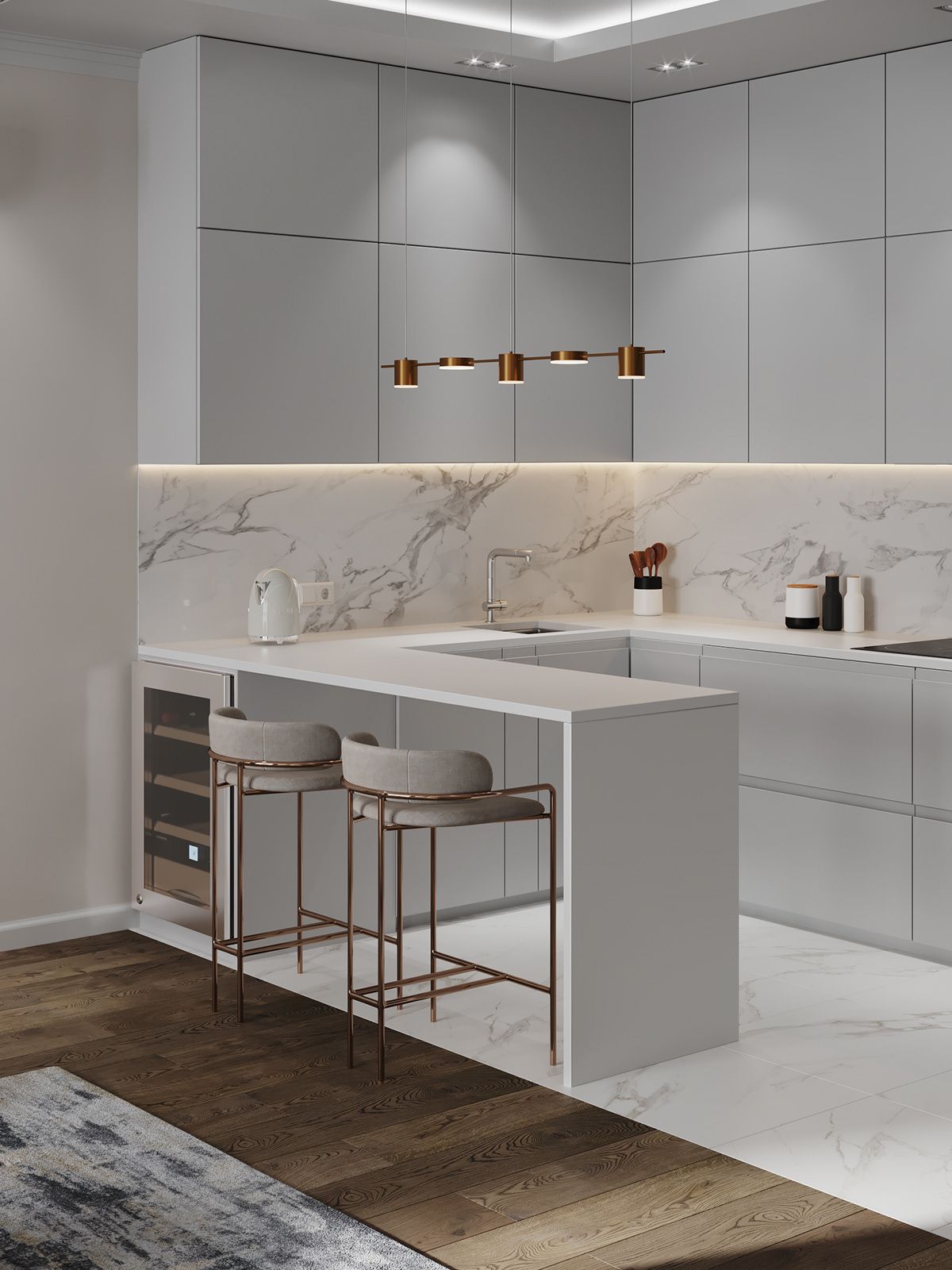A minimalist kitchen design is centered around simplicity, functionality, and clean, uncluttered spaces. This design style strips away unnecessary elements, focusing on essential features that not only serve a practical purpose but also contribute to an aesthetically pleasing, modern kitchen environment. Below are key principles and ideas to create the perfect minimalist kitchen.
1. Embrace a Neutral Color Scheme
A minimalist kitchen often features a neutral color palette to evoke calm and balance. Common choices include shades of white, gray, black, and natural wood tones. These colors provide a timeless and clean backdrop, making the space feel larger and more open. The goal is to keep the design as simple as possible, allowing the materials and layout to shine.
White: Reflects light and makes the space appear larger and brighter.
Gray: Offers sophistication and pairs well with other neutrals.
Wood Tones: Introduces warmth and texture without overwhelming the design.
2. Streamlined, Flat-Front Cabinets
One of the most iconic features of a minimalist kitchen is sleek, flat-front cabinetry. Without ornate detailing or visible handles, these cabinets maintain a clean and modern look. Choose cabinetry that complements the overall theme with either matte finishes or natural wood veneers for a sophisticated touch.
Handleless Designs: To maintain a truly seamless appearance, consider push-to-open mechanisms or integrated handles that blend into the cabinetry.
3. Maximized Storage Solutions
Minimalist kitchens focus on maximizing storage to keep the space tidy and free of clutter. Utilize deep drawers, pull-out shelves, and built-in organizers to store kitchen essentials out of sight. Smart storage options help maintain the uncluttered feel that defines a minimalist space.
Pull-out Pantry: For easy access to dry goods while keeping them hidden.
Deep Drawers: To store larger items like pots, pans, and utensils.
Hidden Bins: Trash and recycling bins can be concealed behind cabinetry for a clean appearance.
4. Seamless, Sleek Countertops
Minimalist countertops should be smooth and unembellished. Materials such as quartz, marble, or concrete are often used in minimalist designs for their sleek and modern finish. Choose solid colors or subtle patterns to keep the surfaces visually calming.
Tips for Countertops:
Quartz: Durable and easy to maintain with a clean finish.
Concrete: Adds an industrial touch with a matte surface.
Marble: Provides luxury and timeless beauty with delicate veins.
5. Integrated Appliances
To keep the kitchen as streamlined as possible, integrate your appliances into the cabinetry. This includes dishwashers, refrigerators, and microwaves. By concealing appliances behind cabinetry panels, they blend seamlessly into the kitchen’s design. This keeps the space looking neat and avoids the visual clutter that can arise from standalone appliances.
Integrated Appliances:
Dishwashers: Hidden behind cabinetry panels to match the kitchen’s aesthetic.
Refrigerators: Built-in designs that align with the surrounding cabinetry.
Cooktops/Ovens: Sleek, modern designs that fit seamlessly into the countertop.
6. Minimal Backsplash
For the backsplash, choose a material that maintains the kitchen’s minimalist vibe. Subway tiles, simple glass panels, or stone slabs work well, but the key is to avoid busy patterns or bright colors that could disrupt the calm aesthetic. A clean, subtle backsplash ensures the space remains visually soothing.
Backsplash Ideas:
White Subway Tiles: Classic and timeless.
Glass Panels: Offer a modern, seamless look.
Stone or Marble: Adds texture and depth with understated elegance.
7. Open Shelving or Closed Storage
Minimalist kitchens can incorporate open shelving, but it should be done thoughtfully. Use open shelves for display purposes only, and keep the items organized and aesthetically pleasing. Alternatively, choose closed cabinetry to keep everything hidden and maintain a clean, streamlined look.
Open Shelving:
Display only a few carefully chosen items (e.g., matching dinnerware, sleek glassware).
Keep shelves organized and uncluttered to avoid visual chaos.
Closed Storage:
Use drawers and cabinets to hide away everyday items.
Opt for pull-out racks or compartmentalized drawers to keep everything in its place.
8. Lighting Design
Lighting is an essential element in any minimalist kitchen. Opt for sleek, functional lighting fixtures that don’t overwhelm the space. Recessed lighting, simple pendant lights, and under-cabinet lighting can illuminate the space without detracting from the overall design. The lighting should highlight key areas such as the kitchen island, sink, and cooking spaces.
Lighting Ideas:
Pendant Lights: Choose simple, geometric designs that complement the kitchen’s style.
Under-Cabinet Lighting: Provides task lighting while keeping the design clean.
Recessed Ceiling Lighting: Subtle and modern, ideal for minimalist spaces.
9. Open Floor Plan
An open floor plan contributes to the minimalist kitchen’s spacious and airy feel. By removing walls or barriers between the kitchen and adjacent living or dining areas, the space feels more expansive and interconnected. This layout also encourages easy flow between different areas, making the kitchen more social and functional.
Open Layout Ideas:
Connect the kitchen with the living or dining area for a cohesive, integrated design.
Consider an island that functions as both a preparation area and a casual dining space.
10. Natural Elements and Simple Accessories
While minimalist design is characterized by simplicity, adding a few natural elements can soften the space and add warmth. A potted plant or a small herb garden can introduce greenery without disrupting the clean lines. Accessories should be kept to a minimum, with only essential or decorative items that align with the minimalist theme.
Natural Elements:
Houseplants: Simple, low-maintenance plants such as succulents or herbs.
Wood Accents: Wooden shelving, cutting boards, or utensil holders to bring warmth to the space.
Conclusion
Designing a minimalist kitchen is about creating a space that feels calm, open, and organized. By focusing on clean lines, neutral colors, integrated appliances, and effective storage solutions, you can create a kitchen that is both functional and aesthetically pleasing. A minimalist kitchen offers a timeless, modern design that maximizes both form and function, ensuring the space remains stylish and efficient for years to come. Whether you’re remodeling or starting from scratch, these design principles can help you achieve a beautiful, clutter-free kitchen.

